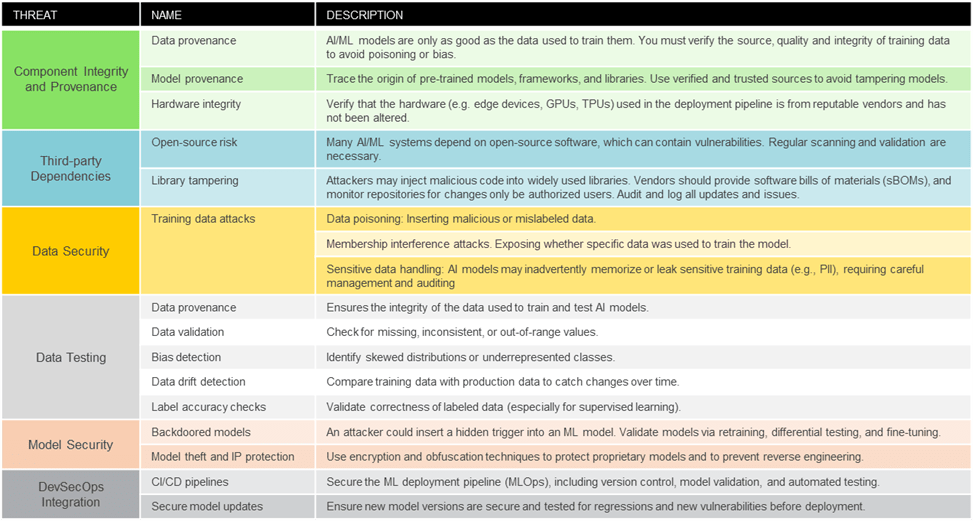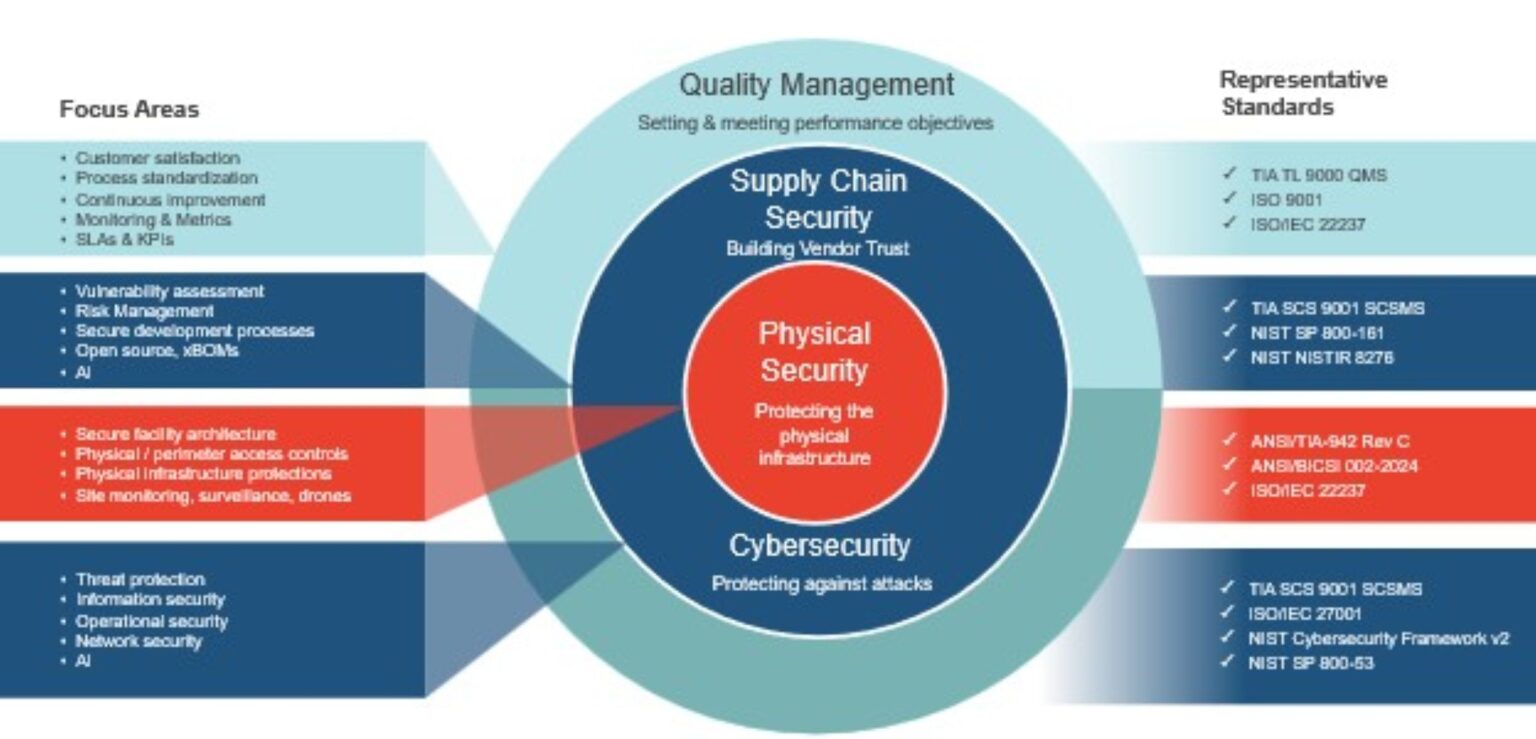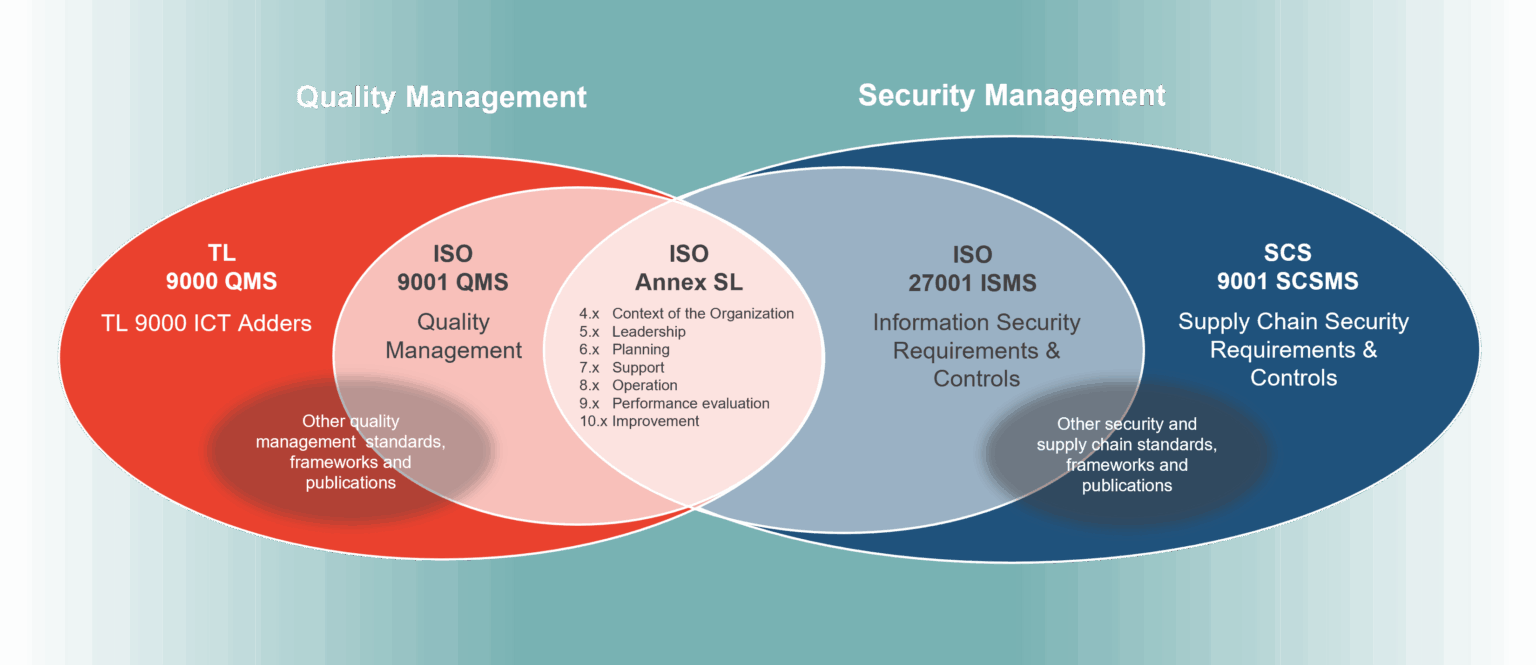Securing AI Data Centers with Integrated Standards

AI-driven workloads and compute-intensive applications are transforming legacy data center infrastructure. As operators shift from CPU-based x86 systems to GPU clusters and specialized accelerators, data center deployments are growing more complex. Meeting the power, cooling, and interconnection demands of high-performance applications requires efficient architecture and management, along with robust security controls.
This article explores how integrated quality and security frameworks backed by industry-led standards can help mitigate risk and improve resilience across the data center lifecycle. It covers evolving data center models, shared vulnerabilities, and real-world incidents. The article also highlights how the Telecommunications Industry Association (TIA) TL 9000, SCS 9001, and ANSI/TIA-942-C standards support scalable, defensible infrastructure.
The Evolution of AI Data Centers
Legacy data centers built on CPU-centric compute architectures typically delivered 10–40 Gbps throughput. Common from the mid-2000s through the early 2020s, many of these facilities hosted virtual machines (VMs) and containers on general-purpose x86 servers. Design priorities primarily focused on cost efficiency, deployment flexibility, and standard air-cooled thermal management.
In contrast, AI-driven data centers host high-density GPU and specialized accelerator clusters that require ultra-high-throughput interconnects (100 Gbps and above) and tightly coupled architectures optimized for performance and parallel processing. Many also incorporate custom hardware—such as FPGAs and ASICs—built for specific AI workloads. These high-performance demands are accelerating adoption of liquid cooling and prompting increased interest in renewable and nuclear power sources to manage rising energy and thermal loads.
An Expansive Architectural Landscape
To support AI-centric infrastructure and high-performance applications, data centers are now more distributed, specialized, and workload-specific. Their role extends beyond compute, virtualization, and storage to enable cloud services, real-time analytics, and globally integrated platforms. These architectures span diverse deployment models, each optimized for latency, scalability, and interconnection.
While not solely dedicated to AI, many data centers integrate AI/ML workloads into broader compute and analytics operations. Examples include:
- Enterprise data centers support internal workloads and applications. They are typically owned and operated by a single organization.
- Colocation facilities (colos) provide shared environments where customers install and manage their own hardware inside data centers operated by a third party.
- Managed services data centers provide fully outsourced infrastructure and operations, maintained and supported by service providers.
- Hyperscale data centers support globally distributed workloads at scale. These large, automated facilities are typically operated by cloud service providers.
- Wholesale data centers lease high-capacity facilities or infrastructure to enterprises and cloud providers, often with limited customization.
- Cloud data centers offer virtualized infrastructure that operates independently of underlying hardware across geographies.
- Edge, micro, and modular data centers reduce latency by bringing compact, prefabricated units closer to users.
- Interconnection hubs facilitate traffic exchange between mobile operators, ISPs, and cloud platforms. This category includes carrier hotels, 5G gateways, and network exchange points.
- Satellite and submarine landing stations connect satellite systems or undersea cables to land-based network infrastructure.
Security Risks and Vulnerabilities
Despite differences in scale, capacity, and function, data centers rely on the same core components: servers, network interface cards (NICs), switches, access points or radios, and storage systems. This architectural ubiquity introduces shared vulnerabilities across supply chains, deployment models, and workloads.
Security risks also extend deep into the software supply chain, where operators find open-source dependencies, model provenance, and malicious code injections increasingly difficult to verify or detect. The table below highlights some of these key vulnerabilities.

Table 1. Key AI/ML data center threats, with examples spanning provenance, dependencies, security, testing, and DevSecOps integration.
Real-World Impact: Security Breaches and Quality Failures
Security failures increasingly demonstrate severe consequences. State-sponsored groups such as Salt Typhoon continue to target both public telecom networks and private data centers in dozens of countries. Active since at least 2019, the group has compromised sensitive communications and infrastructure, including critical U.S. infrastructure.
Quality failures can also disrupt operations as severely as cyberattacks. In July 2024, a faulty CrowdStrike software update crashed more than 8 million Windows systems worldwide, with estimated damages exceeding $5 billion. The incident halted hospital operations, grounded flights, disrupted banking services, and impacted government agencies. Although CrowdStrike maintained strong development and security practices, its public root cause analysis confirmed the absence of a rollback mechanism, phased deployment strategy, and structured quality oversight. All have since been remediated.
Despite their differences, Salt Typhoon and CrowdStrike demonstrate how failures in quality or security—whether exploited externally or introduced internally—can trigger operational outages, reputational harm, and financial loss at global scale.
Integrating Security and Quality for Resilient Operations
Security and quality are inextricably linked in data centers. A lapse in either can lead to service disruptions, data loss, or system compromise, regardless of how well the other is managed.
Despite these risks, many organizations still manage quality and security through disparate teams and processes. Security management systems (SMS) focus on protecting confidentiality, integrity, and availability, while quality management systems (QMS) aim to ensure reliability, consistency, and continuous improvement.
When integrated, QMS and SMS provide a unified foundation for resilience, risk reduction, and coordination across IT, facilities, and vendor ecosystems. Together, they support consistent practices throughout the data center lifecycle, from procurement and development to deployment and recovery.
The Role of Industry Standards in Managing Risk
Industry standards help data center operators manage complexity through structured, scalable processes that promote security, quality, and operational integrity. While no single standard addresses every scenario, an integrated approach supports centralized management systems mapped to infrastructure requirements, workload demands, and system-level risk parameters.
Data Center Quality and Security Hierarchy

Figure 1. A data center security and quality hierarchy chart, highlighting four key domains along with their focus areas and representative standards.
Beyond design and implementation, industry standards also formalize risk management, promote interoperability, and reduce uncertainty. Certification reinforces internal accountability and provides assurance to customers and regulators. In finance, defense, and healthcare—where uptime and data integrity are paramount—certification is often a business requirement. When applied strategically, standards improve operational visibility and strengthen trust in increasingly complex and adversarial environments.
Integrating Quality, Architecture, and Security Standards
TIA develops and continuously updates a complementary set of standards that offers a layered, standards-based approach to quality, architecture, and cybersecurity throughout the data center lifecycle.
- TL 9000 extends ISO 9001 with more than 80 ICT-specific controls, covering software, hardware, and service development. It establishes a foundation for performance and reliability, formalizing metrics, service levels, customer engagement, and lifecycle planning.
- ANSI/TIA-942-C defines requirements for data center architecture, including power, cooling, telecommunications, fire protection, physical security, safety, monitoring, and surveillance. It supports architectural coherence and operational alignment across a wide range of deployment models.
- SCS 9001 provides a comprehensive supply chain security management system (SCSMS). Built on ISO 9001, it extends quality principles into the security domain. SCS 9001 requires organizations to validate controls, assess supplier risk, and embed cybersecurity into procurement and operations. The standard also addresses component traceability, vulnerability assessment, secure development practices, and incident response, with adherence to NIST guidance for federal and international compliance.

Figure 2. TIA’s TL 9000 and SCS 9001 standards bridge ISO Annex SL, providing a unified, centralized structure for integrating security and quality throughout ICT and supply chain systems.
Organizations that implement these standards realize measurable returns through lower incident response costs, faster audits, and increased customer confidence that improves competitiveness in procurement cycles. A unified approach also reduces redundant compliance efforts, enabling teams to allocate resources to innovation instead of managing disconnected quality and security silos.
Conclusion
Incidents like Salt Typhoon and CrowdStrike highlight that QMS and SMS frameworks are only as strong as their weakest link. Effective protection must extend across all relevant security and quality domains. As data centers evolve to support high-performance AI workloads, integrating these frameworks within a unified management system is essential for sustained resilience and control.
TIA’s TL 9000 and SCS 9001 standards, along with ANSI/TIA-942-C, form a complementary foundation for integrated quality management and layered defense. Together, they reinforce infrastructure integrity, operational resilience, and transparency throughout the data center lifecycle.
To learn more or participate in TIA’s standards development, visit tiaonline.org or contact us at membership@tiaonline.org
